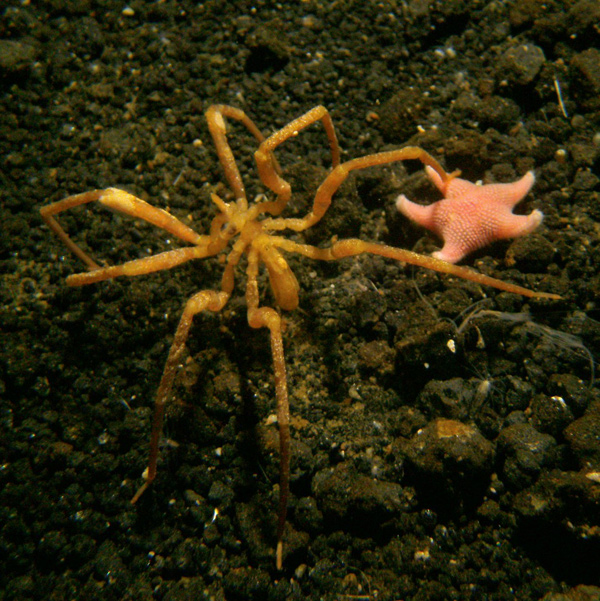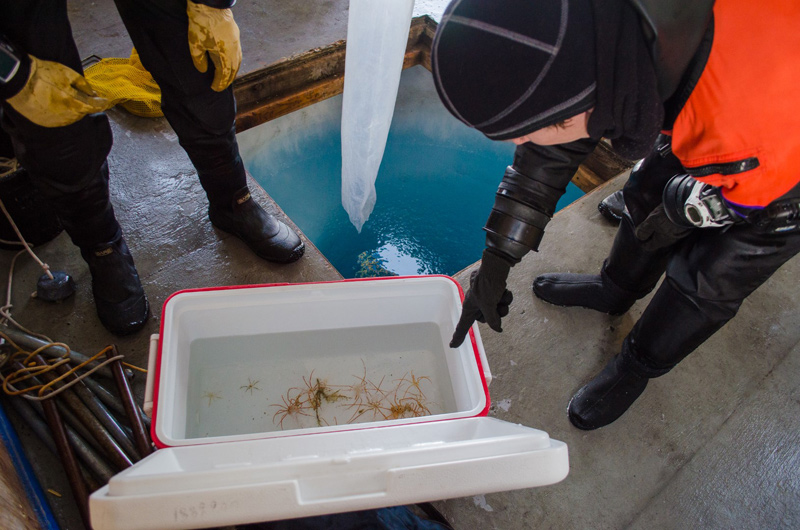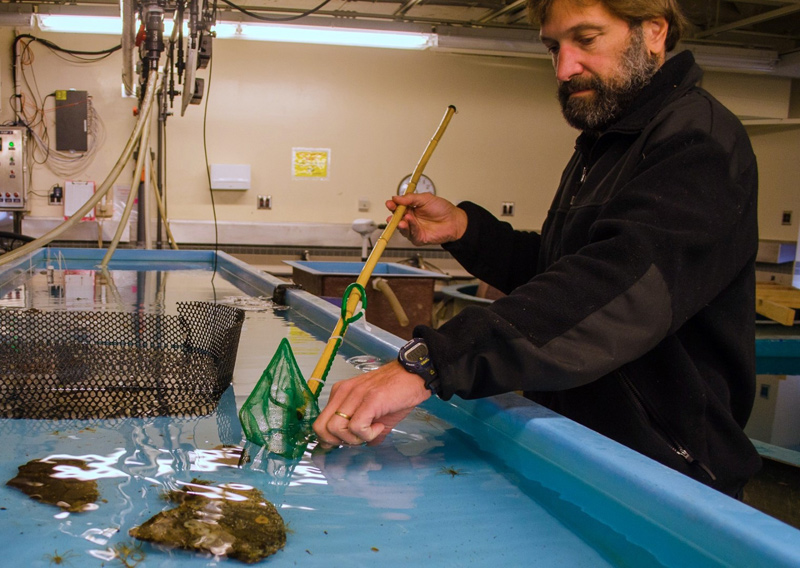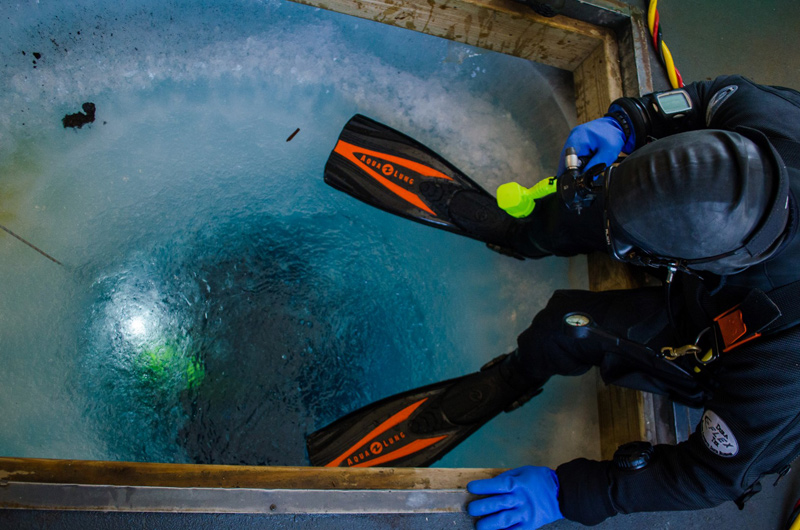Secrets of the Gigantic Sea Spiders (cont.)Posted November 16, 2015

Photo Credit: Bret Tobalske
One of about 190 species of Antarctic sea spiders walks along the bottom of McMurdo Sound, passing by a nearby sea star.
They’ve set up a number of experiments to test these hypotheses. In the Crary Lab’s aquarium, they’re creating an artificial ocean current in a water tank using a small battery-powered outboard motor, to see how well these critters can cling onto the ground. “I think it’s hard for these large ones to resist current,” said Bret Tobalske of the University of Montana. “They get dislodged… they’re not in exquisite control.” It’s complemented by a set of synchronized GoPro cameras that Tobalske has been bringing down on dives. The two movies combine to create a three-dimensional image, offering insight into how well sea spiders can fight the current and maintain control. “We’ve been taking a lot of video, looking at normal postures and how some of these things move around,” Tobalske said. In another corner of the lab, they’re growing several under different oxygen and temperature conditions to see how it affects their growth. 
Photo Credit: Michael Lucibella
Amy Moran points to the sea spider specimens she and her team collected over a day’s worth of diving.
“We’ll put them at three different temperature treatments, typically warmer,” said Caitlin Shishido a graduate student at the University of Hawai´i at Mānoa. “We’ll watch their development over time [for] as long as we’re here.” The expectation is that the ones in cold, oxygen-rich water will develop more slowly and potentially grow bigger than the ones in warmer water. But it opens up another mystery the team is set to investigate, about how the creatures can grow so big and still respire. Sea spiders don’t have lungs or gills. Instead, their blood absorbs oxygen directly from the surrounding ocean through the outermost layer of their exoskeletons, their cuticles. One would expect that as they grow larger, they would develop thicker cuticles to support their increasing weight. But thicker cuticles make it more difficult to absorb oxygen from the water. “That implies a real tradeoff between the ability to respire and the ability to support their weight against current,” Tobalske said. He’ll be using microscopes and a materials strength tester to see whether they have special respiration pores, or if they’re not built as tough as they look to keep their cuticles thin and oxygen flowing. The team brings together a diverse range of expertise. Woods is a physiologist who specializes in insect respiration, while Tobalske spent years studying the biomechanics and fluid dynamics of bird flight. “What I love about working with these guys is that we’re all coming at it from a different perspective,” Moran said, whose own background is in marine ecology. “Not only are they great guys… there’s this sort of cross fertilization of ideas that’s been great for us.” Part of the reason the team is studying these sea spiders now is because of their unclear future at the hands of global climate change. 
Photo Credit: Michael Lucibella
Inside the Crary Lab’s aquarium, Bret Tobalske scoops up one of the smaller sea spiders his team is keeping in the chilled ocean water tank.
“These Antarctic giants, because they’ve adapted for millions of years to constantly cold, constantly high oxygen conditions, in theory they’re fragile metabolic flowers that can’t take much temperature change,” Moran said. More broadly, these experiments are also the chance to make a lot of fundamental observations about how these creatures live and grow. “Really not much is known about their development at all,” Shishido said. There are a lot of outstanding mysteries that the team is gearing up to investigate. Many of the sea spiders’ basic life functions are not well understood, and the team is hoping to broaden the knowledge base just by observing them continuously. Lane’s main experiment is to better understand how well the sea spiders groom algae and bacteria off of themselves, and whether the buildup of that growth affects their ability to absorb oxygen. However in the process he’s witnessed behaviors that have barely entered into the scientific literature. “Some species, they seem to molt their exoskeleton, but it really doesn’t seem to be described very well, if at all,” Lane said. “We’ve had several individuals in the tank here molt, which is really cool.” Woods added that the region is rich in potential research opportunities and new findings. “One thing that’s fun about doing Antarctic science is, because the fauna here are so poorly known, it’s almost like doing discovery science,” he said. “You come down, and you’re guaranteed to find interesting and strange things.” NSF-funded research in this story: Amy Moran, University of Hawai´i at Mānoa, Award No. 1341476 |
"News about the USAP, the Ice, and the People"



For USAP Participants |
For The Public |
For Researchers and EducatorsContact UsU.S. National Science FoundationOffice of Polar Programs Geosciences Directorate 2415 Eisenhower Avenue, Suite W7100 Alexandria, VA 22314 Sign up for the NSF Office of Polar Programs newsletter and events. Feedback Form |


